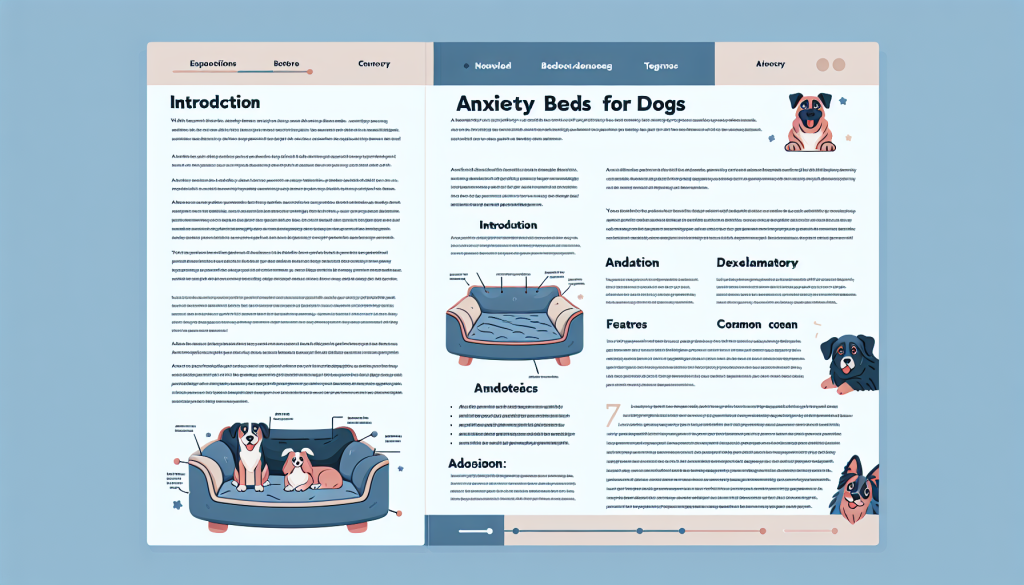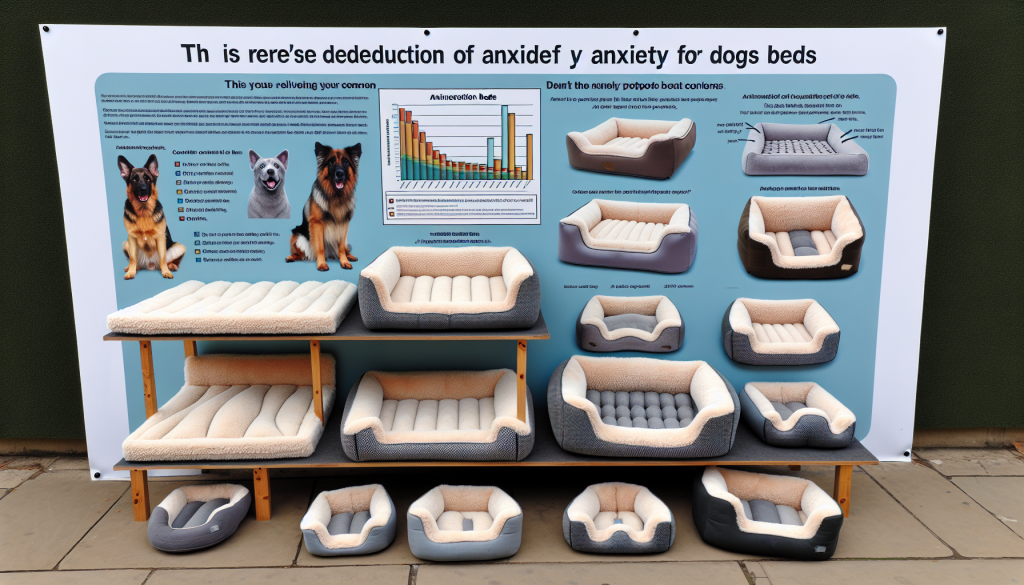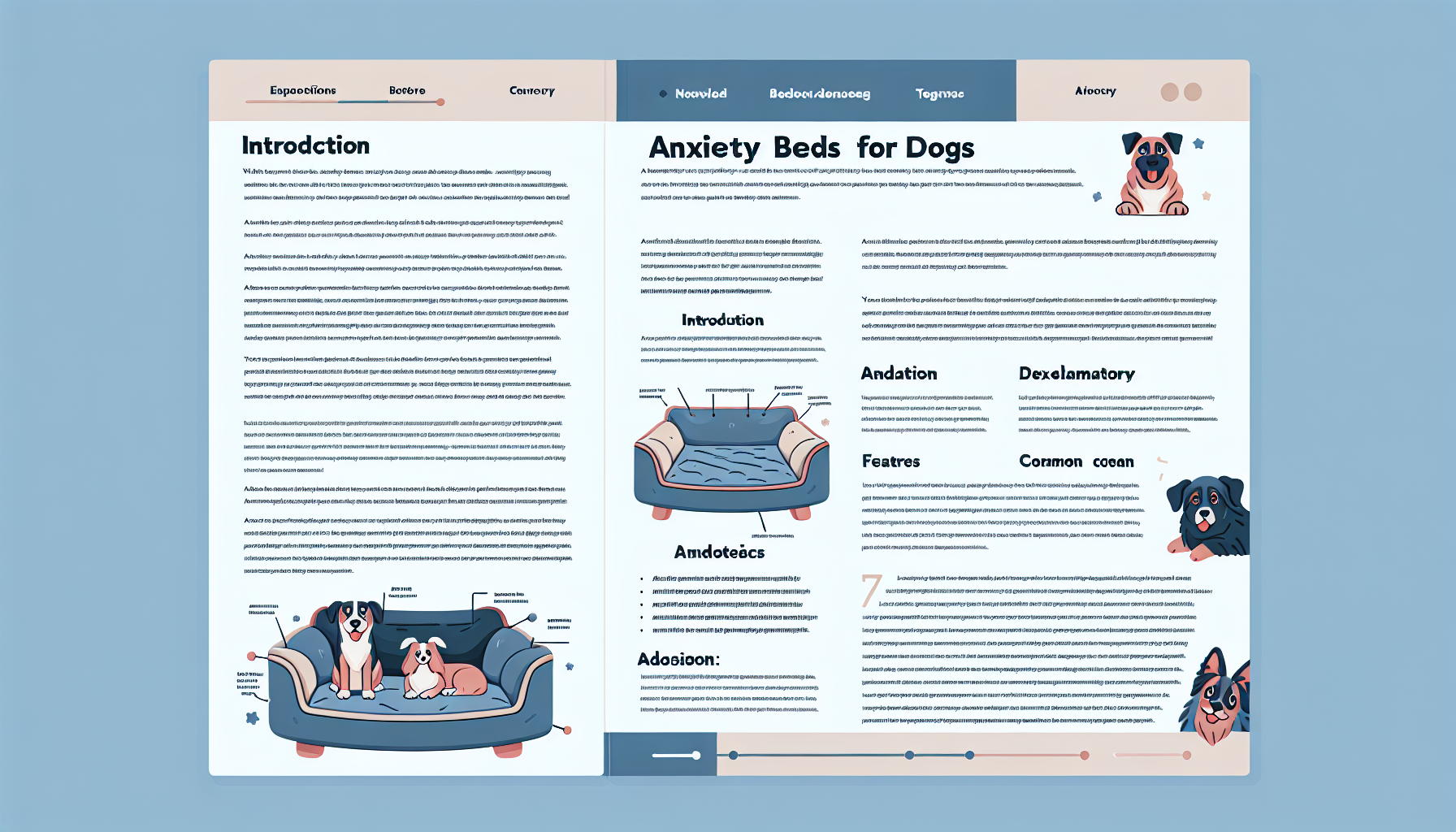If you’ve ever had a furry friend who struggles with anxiety, you know how heartbreaking it can be to see them scared and restless. That’s where anxiety beds come in – designed specifically to provide comfort and support, these beds claim to alleviate anxiety and help dogs feel safe. But do they really work? In this article, we’ll explore the effectiveness of anxiety beds for dogs and whether they live up to the hype.

What are anxiety beds?
Anxiety beds are specially designed beds that are created to help alleviate anxiety and provide comfort to dogs. These beds are carefully designed with various features to help create a sense of security and reduce anxiety symptoms in dogs. They often come in different shapes and sizes, allowing pet owners to choose the best option for their furry friends.
Definition of anxiety beds
Anxiety beds, also known as calming beds or anti-anxiety beds, are pet beds that are designed to provide a safe and secure space for dogs. These beds are typically made with soft and plush materials to provide maximum comfort. They are often designed with raised sides or walls to mimic the feeling of being cuddled or embraced, which helps promote a sense of safety and security in dogs.
How do anxiety beds work?
Anxiety beds work by providing a comforting environment for dogs to relax in. The raised sides or walls of these beds create a cozy and confined space that mimics the feeling of being in a den, which can help alleviate stress and anxiety in dogs. The plush materials used in these beds provide support and comfort, allowing dogs to feel secure and relaxed.
When a dog is experiencing anxiety, they may exhibit behaviors such as pacing, trembling, or excessive barking. Anxiety beds can help redirect these behaviors by providing a safe space for the dog to retreat to. The soft materials and snug design of these beds can help dogs feel protected and reduce their anxiety symptoms.
Understanding dog anxiety
To truly understand the benefits of anxiety beds for dogs, it is important to have a grasp on what causes dog anxiety and how it manifests.
Causes of dog anxiety
Dog anxiety can be caused by a variety of factors, including past traumas, separation anxiety, noise phobias, or changes in their environment. Some dogs may have a genetic predisposition to anxiety, while others may develop it as a result of past experiences or inadequate socialization. It is essential to identify the underlying cause of anxiety before implementing any management strategies.
Signs and symptoms of dog anxiety
Dogs experiencing anxiety may exhibit a range of signs and symptoms. These can include excessive barking, whining, trembling, panting, pacing, destructive behaviors, and even aggression. Some dogs may also refuse to eat or drink when they are feeling anxious. It is important for dog owners to be aware of these signs and seek appropriate measures to alleviate their furry companion’s distress.
Benefits of anxiety beds for dogs
Anxiety beds offer a range of benefits for dogs who struggle with anxiety. Let’s explore some of these benefits in more detail.
Creating a sense of security
One of the primary benefits of anxiety beds is that they create a sense of security for dogs. The raised sides or walls of these beds provide a cozy and enclosed space, giving dogs a safe haven to retreat to when they are feeling anxious. This feeling of security can help reduce anxiety levels and provide comfort to dogs, helping them to feel more at ease in their surroundings.
Reducing anxiety symptoms
Anxiety beds can help alleviate a variety of anxiety symptoms in dogs. The snug design and soft materials of these beds provide physical comfort and support, helping to soothe anxious dogs. The feeling of being surrounded by the raised sides or walls of the bed can also provide a sense of containment, which can reduce feelings of restlessness and promote relaxation in dogs.
Promoting better sleep
Anxiety can often disrupt a dog’s sleep patterns, leading to restless nights for both the dog and their owner. Anxiety beds are designed to promote better sleep by providing a comfortable and secure space for dogs to rest. The plush materials and supportive construction of these beds can help dogs feel more relaxed, allowing them to drift off to sleep more easily and stay asleep for longer periods of time.
Different types of anxiety beds
There are several different types of anxiety beds available for dogs, each with its own unique features and benefits. Let’s explore some of the most common types of anxiety beds.
Cave-style beds
Cave-style anxiety beds are designed to mimic the feeling of a den, providing dogs with a safe and enclosed space to retreat to. These beds have a hooded or covered top that creates a cave-like structure, allowing dogs to snuggle up and feel protected. Cave-style beds are particularly beneficial for dogs who prefer to hide or burrow when they are feeling anxious.
Donut-shaped beds
Donut-shaped anxiety beds are circular in shape and feature raised sides surrounding the entire bed. These beds are often made with soft and plush materials, providing dogs with a cozy and secure space to curl up in. The circular shape of these beds allows dogs to rest their heads or lean against the sides, offering additional support and comfort.
Orthopedic beds
Orthopedic anxiety beds are designed with extra support and cushioning to provide relief for dogs with joint or muscle pain. These beds are often made with memory foam or other high-density materials that conform to the dog’s body, relieving pressure points and promoting better spinal alignment. Orthopedic beds can be particularly beneficial for older dogs or those with arthritis who may experience increased anxiety due to physical discomfort.
Weighted blankets
Weighted blankets are a newer addition to the world of anxiety beds for dogs. These blankets are designed to provide gentle pressure and simulate the feeling of being hugged or cuddled. The weight of the blanket can help promote relaxation and reduce anxiety symptoms in dogs. Weighted blankets can be used on their own or in combination with other types of anxiety beds.

Factors to consider when choosing an anxiety bed
When choosing an anxiety bed for your dog, there are several factors to consider to ensure that you select the most suitable option. Let’s explore these factors in more detail.
Size and breed of the dog
The size and breed of your dog will play a crucial role in determining the appropriate size of the anxiety bed. You want to make sure that the bed is large enough for your dog to stretch out comfortably, but not so large that they feel overwhelmed or unsupported. Consider your dog’s size, weight, and sleeping habits when selecting the size of the bed.
Materials and construction
The materials and construction of an anxiety bed can greatly impact its comfort and durability. Look for beds that are made with high-quality, non-toxic materials that are soft and plush. Pay attention to the bed’s stitching and overall construction to ensure it is built to last. It’s also important to consider whether or not the materials are hypoallergenic, especially for dogs with allergies or sensitivities.
Ease of cleaning
Keeping your dog’s bed clean is essential for their health and well-being. Look for anxiety beds that are easy to clean, preferably machine washable. Removable covers can also make it easier to maintain cleanliness and manage any accidents or spills. Consider the bed’s cleaning instructions and whether or not it can withstand regular washing without losing its shape or quality.
Price and budget
Anxiety beds can vary significantly in price, depending on the brand, size, and materials used. Set a budget for your dog’s bed and take the time to compare different options within your price range. Remember that investing in a high-quality bed may provide greater comfort and durability in the long run, potentially saving you money on replacements.
Research on anxiety beds for dogs
Research supporting the effectiveness of anxiety beds for dogs is still relatively limited, but some studies have shown promising results. Let’s explore the existing research on anxiety beds for dogs.
Studies supporting the effectiveness of anxiety beds
A study published in the Journal of Veterinary Behavior found that anxiety beds can significantly reduce anxiety-related behaviors in dogs. The study involved observing dogs with diagnosed anxiety disorders and monitoring their behavior when provided with an anxiety bed. The results showed a decrease in anxious behaviors such as pacing, panting, and restlessness when the dogs had access to the anxiety bed.
Another study published in the journal Applied Animal Behaviour Science found that the use of anxiety beds can reduce cortisol levels in anxious dogs. Cortisol is a stress hormone, and lowered levels indicate reduced stress and anxiety. The study also indicated that dogs using anxiety beds showed an increase in relaxed behaviors and reduced signs of physiological stress.
Criticism and limitations of the research
While the research on anxiety beds for dogs is promising, it is important to acknowledge the limitations and be cautious of generalizing the results. Many of the studies conducted have been small-scale and focused on specific populations of dogs. Additionally, there is a lack of standardized protocols and measurement tools across studies, making it challenging to compare results. Further research is needed to fully understand the effectiveness of anxiety beds and their long-term effects on dogs.
Tips for using anxiety beds effectively
To ensure that anxiety beds are used effectively for your dog, consider the following tips:
Introducing the bed to your dog
Introduce the anxiety bed to your dog gradually, allowing them to explore and familiarize themselves with it at their own pace. You can place treats or toys on the bed to create positive associations. Encourage your dog to spend short periods of time on the bed and gradually increase the duration over time.
Creating a calming environment
In addition to using an anxiety bed, create a calming environment for your dog. This can include playing soft music, using pheromone diffusers or sprays, and providing appropriate toys or chew treats. Avoid loud noises or stress-inducing activities that may counteract the comforting effects of the anxiety bed.
Establishing a routine
Consistency is key when using an anxiety bed. Establish a daily routine for your dog, including regular bedtimes and periods of relaxation on the anxiety bed. Dogs thrive on routine, and having a predictable schedule can help reduce anxiety and provide a sense of stability.
Alternative methods for managing dog anxiety
While anxiety beds can be an effective tool for managing dog anxiety, they may not be the sole solution for every dog. Here are some alternative methods that can be used in conjunction with anxiety beds:
Behavioral training
Behavioral training can help dogs develop coping mechanisms and better manage their anxiety. Working with a professional dog trainer or behaviorist can provide guidance and support in implementing training techniques that address the specific causes of your dog’s anxiety.
Calming supplements or medications
In some cases, dogs may benefit from the use of calming supplements or medications to help manage their anxiety. Consult with a veterinarian to determine if these options are appropriate for your dog. It’s important to note that while these supplements and medications can be helpful, they should always be used under the guidance of a veterinary professional.
Therapeutic massages or exercises
Therapeutic massages and exercises can be beneficial in reducing anxiety and promoting relaxation in dogs. Massages can help relieve muscle tension and provide a soothing experience for your furry friend. Additionally, engaging in regular exercise can help release endorphins, which can improve your dog’s overall mood and well-being.
Real-life experiences and testimonials
Real-life experiences and testimonials from dog owners can provide valuable insights into the effectiveness of anxiety beds. Many pet owners have reported positive outcomes when using anxiety beds for their dogs. They have shared stories of their dogs finding comfort, experiencing fewer anxiety symptoms, and overall improved well-being. However, it’s important to remember that every dog is unique, and what works for one may not work for another. It’s always wise to consult with a veterinarian and consider professional guidance when managing dog anxiety.
Conclusion
Anxiety beds can be a valuable tool in managing dog anxiety and promoting their overall well-being. These specially designed beds offer a sense of security, reduce anxiety symptoms, and promote better sleep for dogs. When choosing an anxiety bed, factors such as size, materials, and ease of cleaning should be considered. While research on anxiety beds is still limited, many studies show promising results. It is important to introduce the bed gradually, create a calming environment, and establish a routine for optimal effectiveness. Alternative methods such as behavioral training, calming supplements, and therapeutic exercises can be used in conjunction with anxiety beds to provide comprehensive anxiety management for dogs. Real-life experiences and testimonials from dog owners further illustrate the potential benefits of anxiety beds. By understanding and addressing dog anxiety, and with the help of anxiety beds, we can provide our beloved canine companions with the comfort and support they need to thrive.
